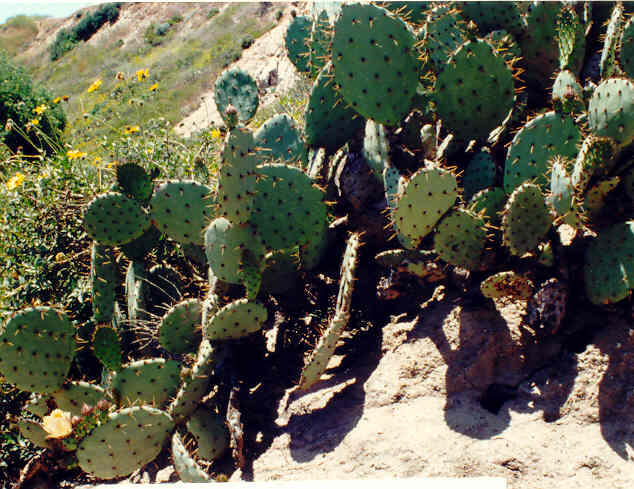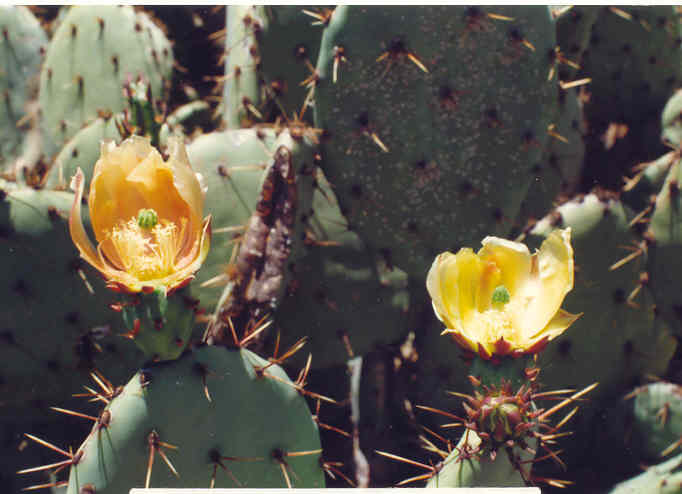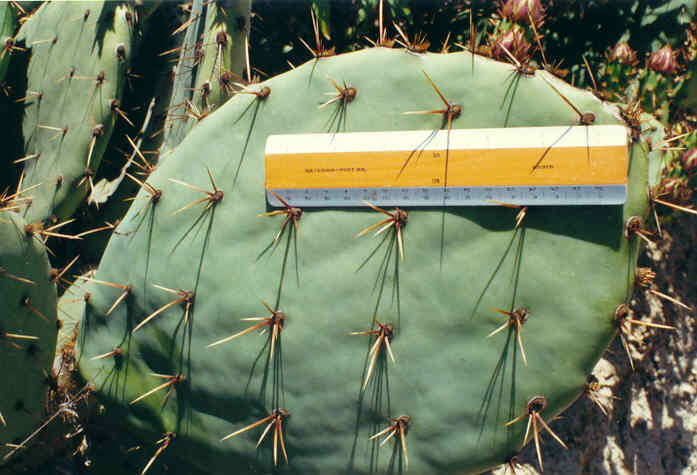
Opuntia x occidentalis Engelm.
Cactaceae
(Cactus Family)
Native
 |
Opuntia x occidentalis Engelm.Cactaceae
(Cactus Family)
Native
Western Prickly Pear |
Plant Characteristics:
Stem sprawling to +/- erect, < 1 meter tall; segments flat, 19-35 cm.
long, generally obovate; spines 3-6 in 90-100% of areoles, generally flat,
generally straight, longest 2.5-5 cm., +/- spreading, upper 1-2 yellow, whitish
coated, base brown, lower 2-4 shorter, +/- reflexed; lvs. awl shaped, +/-
appressed, to 15 mm. long, reddish; inner perianth yellow to deep pink;
filaments generally yellow; style pink to white, stigma green; fr. 4.5-5 cm.,
juicy, red-purple throughout; areoles 24-30; seed 4-5.5 mm.
Habitat:
Subcoastal hillsides and washes, Upper Sonoran Zone; from Ventura County,
to northern Lower California, occasionally reaching the coast from Los Angeles
County southward. Below 400 m. April-July.
Name:
Possibly from the Papago Indian name opun,
for this food plant; or named for a spiny plant of Opus,
Greece. (Hickman Ed. 452). Latin, occidentalis,
western. (Jaeger 170).
General:
Found on the bluff sides along the westerly side of the Upper Bay.
The frequency of the plant appears to be occasional. However, until one
is familiar with its characteristics, it is hard to discern from the other Opuntias and it may be more common than I think. (my comments).
There is confusion over what O. occidentalis really is, although the name
is widely used in floras. The plant
generally known under this name occupies a territory throughout most of Orange
County and inland to the foothills of the San Gabriel Mountains. A distinctive
characteristic is the long awl-shaped leaf on the young pads, sometimes longer
than half an inch. (Dawson 39).
The filleted pads of Prickly Pear species are beautifully effective
drawing poultices. Place them
against the parts injured, cover in gauze, and tape to the skin; remove after
several hours. The
mucopolysaccharide gel in the Prickly Pear flesh is strongly hydrophilic and
hypertonic; some of the fluid exudates that build up in the injury are absorbed
osmotically through the skin and into the cactus, while the gel softens the
skin, decreases the tension against injury, and lessens the pain.
This is, by the way, how Aloe Vera works.
Finally, small, skinned sections may be held between the gum and cheek to
lessen the pain and inflammation from gum infections and mouth sores.
Recent studies with adult-onset of diabetics in Mexico have shown that
the folk use of Prickly Pear for diabetes is clinically verifiable.
There was a clear hypoglycemic effect on the obese, insulin-resistant
patients, with simultaneously lowered serum levels of low-density cholesterols
and triglycerides. (Moore, Medicinal
Plants of the Desert and Canyon West 90).
A series of hybrids between cult. prickly pears and the native spp.,
hence in many different forms. (Munz,
Flora So. Calif. 318).
O. x occidentalis is a hybrid
of O. littoralis x (O. engelmannii x O.
phaeacantha).
(Hickman, Ed. 455).
Roberts in his 1998 edition of A Manual Of The Flowering Plants
of Orange County California does not list O. occidentalis.
Text Ref:
Abrams Vol. III 152; Dawson 39; Hickman, Ed. 455; Munz, Flora
So. Calif. 318.
Photo Ref:
April-May 94 #11A,12A,13A.
Identity: by R. De Ruff.
First Found: May 1994.
Computer Ref: Plant Data 471.
No plant specimen.
Last edit 11/28/03.
 |
 |
May Photo May Photo